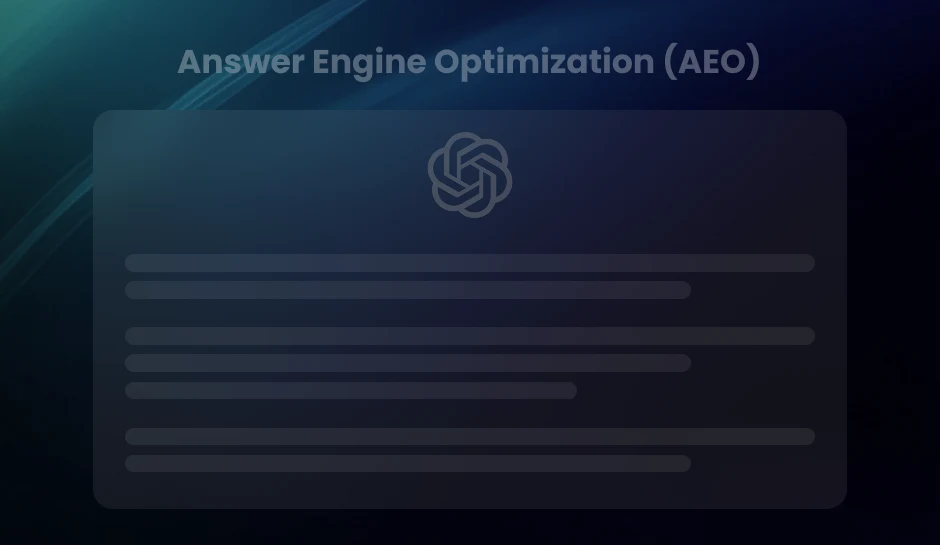
Post-View Attribution: Redefining Success in the Age of Multichannel Marketing
Understanding the true influence of your ads is crucial. Post-view attribution goes beyond clicks, offering valuable insights into how impressions shape customer decisions and drive conversions. This approach helps businesses optimize their campaigns and maximize ROI by accounting for the hidden impact of ad exposure. Read the blog to explore how this approach can optimize your campaign and ROI.
What if your most successful marketing campaigns were overlooked simply because they didn’t generate clicks? In a world where every impression counts, are you confident your business is truly measuring the full impact of its advertising efforts?
For many businesses, the challenge lies in deciphering the intricate customer journey. Traditional attribution models tend to favor clicks, dismissing the influence of non-clicked impressions. This approach often underestimates the value of brand exposure, leaving decision-makers with an incomplete picture of what drives conversions. As a result, high-performing channels can go unnoticed, budgets may be misallocated, and ROI potential remains untapped.
Enter post-view attribution—a powerful methodology that captures the hidden influence of ad impressions. Post-view attribution bridges the gap between brand visibility and measurable outcomes by attributing value to ads that were seen but not clicked. It offers businesses the clarity they need to make data-driven decisions, ensuring every dollar spent on advertising is accounted for.
How Post-View Attribution Complements Click-Based Models
For years, click-based attribution has dominated marketing analytics. It’s simple, measurable, and directly links a user’s action and an ad. But here’s the problem: not all consumer decisions are linear, and not all ads are designed to elicit an immediate click. Relying solely on click-based models often results in an incomplete picture, ignoring the influence of ads that drive awareness, consideration, and even subconscious brand affinity.
Post-view attribution addresses this blind spot by recognizing the impact of impressions—ads that are seen but not clicked—on eventual conversions. This is particularly valuable in campaigns focused on brand awareness or upper-funnel activities, where the goal isn’t an immediate action but planting the seed for future engagement.
For example, a user might see a display ad for a luxury product, continue browsing other websites, and later return to make a purchase directly. A click-based model would fail to credit the display ad, even though it played a crucial role in decision-making. Post-view attribution ensures that the value of such interactions is accounted for, offering a more balanced perspective on campaign performance.
By complementing click-based models, post-view attribution allows businesses to:
- Identify the true ROI of branding campaigns.
- Optimize ad spend across channels, ensuring resources aren’t disproportionately allocated to last-touch clicks.
- Gain a deeper understanding of the entire customer journey, not just the endpoints.
This expanded lens reveals hidden opportunities, helping businesses recognize which strategies silently drive results and which may need adjustment.
What Makes Post-View Attribution Complex and Powerful
While the concept of post-view attribution may seem simple, its implementation reveals a layer of complexity that is both challenging and rewarding. Unlike click-based models, post-view attribution requires marketers to investigate data collection, measurement accuracy, and interpretation.
1. The Role of Viewability
Not every impression leaves an impact. For post-view attribution to be effective, it must account for whether an ad was genuinely viewable. This involves measuring factors such as screen placement, time in view, and whether the user’s attention was likely captured. Without addressing viewability, businesses risk attributing value to ads that users never truly saw.
2. Timing and Attribution Windows
Determining how long an impression remains influential is another critical factor. Attribution windows define the period during which an ad impression can reasonably be tied to a conversion. Too short, and you risk undervaluing your campaigns. Too long, and you might over-credit ads for conversions influenced by other factors. Striking the right balance requires careful analysis and alignment with campaign goals.
3. Cross-Device and Cross-Platform Tracking
Today’s consumers rarely stick to a single device. They might see an ad on a smartphone, research the product on a laptop, and complete the purchase on a tablet. Capturing this multi-device journey is essential for accurate post-view attribution but poses significant challenges in data integration and tracking.
4. Privacy and Regulatory Constraints
With increasing emphasis on user privacy, regulations like GDPR and CCPA have limited the data marketers can collect. While this is a step forward for consumer protection, it complicates attribution efforts by reducing access to granular user data. To maintain accuracy, businesses must rely on aggregated insights and privacy-compliant methodologies, such as contextual targeting and first-party data.
5. Avoiding Over-Attribution
When applied without rigor, post-view attribution can over-credit impressions and lead to skewed insights. To avoid this, businesses must integrate it within a multi-touch attribution framework considering all touchpoints along the customer journey.
Pro Tip- These complexities highlight why post-view attribution isn’t just a plug-and-play solution but a strategic tool that demands thoughtful implementation. However, the payoff is substantial for businesses willing to invest the effort: a deeper understanding of customer behavior, more precise ROI calculations, and smarter decision-making across campaigns.
Advanced Insights: Understanding Hidden Patterns with Post-View Attribution
Post-view attribution doesn’t just redistribute credit, it transforms how businesses interpret customer behavior, evaluate campaigns, and plan future strategies. Here are several ways it unlocks hidden insights that drive actionable, data-backed decisions:
1. Identifying High-Performing Channels and Creatives
Traditional models may undervalue channels or creatives that influence conversions indirectly. With post-view attribution, businesses can uncover which impressions lead to meaningful engagement down the funnel.
- Channel-Level Insights: Learn which platforms (e.g., display networks, social media) generate the most influential impressions—even without direct clicks.
- Creative-Level Insights: Analyze ad formats, imagery, or messaging that resonate most with your target audience, ensuring resources are allocated to impactful designs.
For example, a static banner ad may lack clicks but drive brand recall that contributes to conversions when paired with follow-up email campaigns or organic search activity.
2. Enhanced Audience Segmentation
Post-view attribution enables a more nuanced understanding of audience behavior.
- Segment Analysis: Understand which audience groups are influenced by non-click interactions.
- Behavioral Patterns: Identify differences in engagement across demographics, geographies, and customer types.
For instance, a younger demographic may respond positively to high-frequency video ads, while professionals might engage more after seeing a single targeted impression. These insights allow marketers to customize campaigns for specific segments, maximizing relevance and effectiveness.
3. Measuring the Value of Branding Campaigns
One of the biggest challenges in advertising is proving the ROI of branding efforts, which focus on awareness and perception rather than immediate action. Post-view attribution provides a framework for quantifying these effects.
- Long-Term Impact: Assess how branding campaigns influence purchase intent and customer lifetime value (CLV).
- Campaign Optimization: Use impression-based data to refine targeting, messaging, and frequency for ongoing branding efforts.
For example, a luxury auto manufacturer running display campaigns can track how impressions correlate with dealership visits, even months later.
4. Leveraging Predictive Analytics with Post-View Data
Post-view data serves as a foundation for advanced predictive modeling.
- Forecasting Outcomes: Use historical post-view data to anticipate which campaigns, channels, or ad types will likely generate the highest influence.
- Budget Allocation: Predict which touchpoints offer the best ROI, allowing businesses to optimize ad spend precisely.
- Campaign Experimentation: Simulate changes in impression volume or creative strategy to gauge potential impacts before implementation.
For instance, predictive models might reveal that a 20% increase in display ad impressions results in a 5% uptick in conversions, enabling confident decision-making.
5. The Halo Effect: Synergies Across Channels
Post-view attribution highlights how interactions in one channel amplify performance in others.
- Cross-Channel Influence: Discover how display ads boost the effectiveness of other touchpoints, such as paid search or retargeting campaigns.
- Strategic Integration: Use this data to coordinate multi-channel strategies for better customer experiences and higher ROI.
For example, a travel brand might find that impressions from a Facebook carousel ad lead to increased clicks on Google search ads, justifying combined budget planning.
6. Understanding Time-to-Impact
Not all impressions drive immediate conversions, but understanding their time-to-impact can guide better campaign pacing and optimization.
- Attribution Windows: Post-view data reveals how long an impression remains relevant to conversion behavior.
- Ad Frequency Insights: Pinpoint the optimal frequency for serving ads without diminishing returns or causing audience fatigue
Practical Applications for Leaders
Post-view attribution is more than a marketing metric—it’s a strategic tool that drives informed decision-making across business functions. Here’s how leaders can use it to achieve tangible business outcomes:
1. Smarter Budget Allocation
Post-view attribution reveals where your advertising dollars are making the most impact, even when conversions aren’t directly tied to clicks.
- Reallocate Resources: Identify underperforming channels and shift budgets to high-impact impressions.
- Justify Branding Spend: Demonstrate the ROI of awareness campaigns that generate long-term value but lack immediate action.
- Balance Upper and Lower Funnels: Ensure investments in brand-building and performance-driven campaigns are proportionate and effective.
For instance, an analysis might show that display ads in premium publications generate significant post-view conversions, prompting increased investment in such placements.
2. Measuring Branding Campaign ROI
Branding campaigns often aim to plant seeds of future engagement, which traditional attribution models overlook. Post-view attribution quantifies their value by connecting impressions to downstream conversions.
- Link Awareness to Action: Show how non-clicked ads influence direct traffic, organic searches, or eventual purchases.
- Prove Campaign Effectiveness: Provide data-backed evidence to stakeholders about the impact of visibility campaigns.
For example, a consumer goods company might find that video impressions during peak TV hours contribute to online purchases later in the week, validating their cross-channel strategy.
3. Strengthening Cross-Departmental Collaboration
Insights from post-view attribution can bridge the gap between marketing and sales teams by providing a shared understanding of customer behavior.
- Align Strategies: Use data to create cohesive strategies where marketing efforts complement sales outreach.
- Better Lead Scoring: Incorporate impression data into lead scoring models, enabling sales teams to prioritize prospects exposed to high-impact ads.
4. Driving Customer Experience Improvements
Post-view attribution offers a granular view of how consumers interact with your brand, helping refine customer experiences.
- Refine Messaging: Analyze which ad creatives and channels resonate most with different audience segments.
- Enhance Personalization: Use insights to deliver more targeted and relevant campaigns at every funnel stage.
- Optimize Touchpoints: Ensure seamless customer journeys by identifying and reducing drop-off points between impressions and conversions.
5. Competitive Advantage in a Privacy-Conscious World
As privacy regulations tighten, businesses face increasing pressure to demonstrate the effectiveness of their marketing without relying heavily on third-party cookies or invasive tracking.
- Leverage First-Party Data: Combine post-view attribution insights with first-party data to maintain accuracy while adhering to privacy laws.
- Focus on Contextual Targeting: Identify high-performing channels and audiences without intrusive user tracking.
A retail brand, for instance, might use post-view attribution to determine which in-store promotions were influenced by digital impressions, using anonymized aggregated data.
Avoiding Common Pitfalls and Misinterpretations
While post-view attribution can provide valuable insights into campaign performance, it’s crucial to avoid some common pitfalls that can lead to misinterpretation of data and suboptimal decision-making. Let’s explore a few key mistakes and how to avoid them.
Over-Attributing to View-Through Conversions
A common mistake in post-view attribution is over-attributing conversions to view-through actions. Understanding that not all conversions are directly influenced by an impression is essential. When you set a lookback window too long, you may unintentionally credit conversions to an initial ad impression that didn’t significantly contribute to the decision-making process.
How to Avoid the Pitfall: Be mindful of your lookback window’s length. A longer window can help capture delayed conversions, but if it’s too long, it may overstate the impact of earlier touchpoints. Always assess the context of the impression and whether it was truly influential in the conversion process, rather than just attributing the conversion to the last touchpoint in a long sequence.
Focusing Solely on Last-Click
Another common pitfall is relying exclusively on last-click attribution, which only gives credit to the final touchpoint before a conversion. While this model is useful for measuring direct results, it fails to capture the cumulative impact of earlier touchpoints—like display ads or video campaigns—that build awareness and influence the consumer’s decision-making process.
How to Avoid the Pitfall: Expand your attribution model beyond last-click. Post-view attribution helps highlight the role of upper-funnel activities, but combining it with first-touch or multi-touch attribution gives a more comprehensive picture of how different touchpoints contribute to conversions. This broader approach lets you see the value of direct and indirect interactions.
Ignoring the Impact of Other Channels
Post-view attribution can offer great insights into the impact of display and video ads, but it’s important to remember that it should not be used in isolation. Other channels, such as search, email, and social media, play a critical role in driving conversions, and ignoring their impact can result in a skewed understanding of campaign performance.
How to Avoid the Pitfall: Use post-view attribution as a holistic measurement strategy. Combine it with other attribution models and metrics to capture the full customer journey across multiple channels. This helps ensure that no part of the funnel is overlooked, and it provides a more complete picture of how each channel influences the final conversion.
Key Takeaways
- Post-view attribution enables businesses to accurately measure the impact of ad impressions, especially for upper-funnel activities that don’t result in immediate clicks.
- It allows for a more comprehensive understanding of the customer journey by capturing the role of brand exposure in driving conversions.
- Combining post-view attribution with click-based models allows businesses to uncover hidden insights that help optimize campaign strategies and budget allocation.
- Post-view attribution helps marketers evaluate the effectiveness of brand-building campaigns, proving their value in generating long-term conversions.
- Properly managing attribution windows and integrating multi-touch attribution is crucial to avoid over-crediting and ensure accurate measurement of the entire customer journey.
Conclusion
Relying solely on click-based attribution models can leave significant gaps in understanding your campaigns’ full impact. Post-view attribution helps bridge these gaps by acknowledging the influence of impressions, especially in brand-building and upper-funnel activities. Integrating with other attribution models provides a holistic view of customer behavior, enabling smarter decisions, improved budget allocation, and more effective marketing strategies. This deeper understanding of customer engagement leads to better ROI and long-term business growth.
To optimize your marketing strategy and gain valuable insights
reach out to us at info@diggrowth.com and discover how post-view attribution can transform your approach to campaign measurement.
Ready to get started?
Increase your marketing ROI by 30% with custom dashboards & reports that present a clear picture of marketing effectiveness
Start Free Trial
Experience Premium Marketing Analytics At Budget-Friendly Pricing.

Learn how you can accurately measure return on marketing investment.
Additional Resources
Don’t Let AI Break Your Brand: What Every CMO Should Know
AI isn’t just another marketing tool. It’s changing...
Read full post postFrom Demos to Deployment: Why MCP Is the Foundation of Agentic AI
A quiet revolution is unfolding in AI. And...
Read full post postAnswer Engine Optimization (AEO): The New Frontier of SEO in 2025
As digital experiences continue to evolve, so does...
Read full post postFAQ's
Post-view attribution measures the impact of ad impressions on conversions, even if no immediate click occurs. View-through attribution specifically focuses on attributing conversions to those who saw an ad but didn’t click before converting.
Yes, post-view attribution is especially valuable for video ads, as it can measure the influence of video exposure in driving conversions, even if viewers don’t click or engage immediately after watching.
The ideal lookback window depends on your campaign goals and customer behavior. Shorter windows work for immediate conversions, while longer windows can capture the delayed effects of brand awareness activities. Experimentation can help find the right balance.
Post-view attribution relies on cross-device tracking to attribute conversions across multiple devices. However, tracking users across devices requires robust data integration, ensuring that all touchpoints, from mobile to desktop, are considered in conversion modeling.
Post-view attribution typically focuses on online behaviors, but insights can be integrated with offline data like in-store visits. Combining online and offline metrics offers a more comprehensive view of how digital ads influence offline actions.


